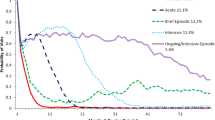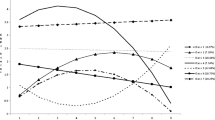Abstract
Sociodemographic, family-environmental, clinical, and service use differences among younger (3–6 years), middle (7–10 years), and older (11–16 years) children admitted to a child psychiatric inpatient service were examined. Data was collected retrospectively on 327 children using a 152-item chart abstraction form from the children's medical charts in years 1993, 1995, 1996, and 1997. The results suggest that younger children compared to their older counterparts come from poorer functioning families and that family-environmental, rather than clinical, diagnostic variables differentiate these groups. Implications of the findings for future research and practice are discussed.
Similar content being viewed by others
References
Causey DL, Robertson JM, Elam SM: Characteristics of toddlers and youngsters exhibiting severe psychiatric disturbance. Child Psychiatry Hum Dev 29: 33-48, 1998.
Blotcky MJ, Dimperio TL, Gossett JT: Follow-up of children treated in psychiatric hospitals: a review of studies. Am J Psychiatry 141: 1499-1507, 1984.
Pfeiffer SI, Strzelecki SC: Inpatient psychiatric treatment of children and adolescents: a review of outcome studies. J Am Acad Child Adolesc Psychiatry 29: 847-853, 1990.
Scahill L, Riddle MA: Psychiatrically hospitalized children: a critical review. Yale J Biol Med 63: 301-312, 1990.
Heller TL, Baker BL, Henker B, Hinshaw SP: Externalizing behavior and cognitive functioning from preschool to first grade: stability and predictors. J of Clin Child Psychol 25: 372-375, 1996.
Dalton R, Forman MA, Daul GC, Bolding D: Psychiatric hospitalization of preschool children: admission factors and discharge implications. J Am Acad Child Adolesc Psychiatry 26: 308-312, 1987.
Rosenthal PA, Rosenthal S, Doherty MB, Santora D: Suicidal thoughts and behaviors in depressed hospitalized youngsters. Am J Psychother 40: 201-212, 1986.
Mansheim P: Short-term psychiatric inpatient treatment of younger children. Hospital Community Psychiatry. 41: 670-672, 1990.
American College of Psychiatrists: Inpatient treatment of adolescents: update. 1990.
Birmaher B, Ryan N, Williamson D, Brent D, Kaufman J, Dahl R, Perel J, Nelson B: Childhood and adolescent depression: a review of the past 10 years. Part I. J Am Acad Child Adolesc Psychiatry 35: 1427-1439, 1996.
American Psychiatric Association: Diagnostic and Statistical Manual of Mental Disorders, 4th edition (DSM-IV). Washington, DC: American Psychiatric Association, 1994.
Zito JM, Safer DJ, dosReis S, Gardener JF, Boles M, Lynch: Trends in the prescribing of psychotropic medications to youngsters. JAMA 283: 1025-1060, 2000.
Shirk SR: Integrated child psychotherapy: Treatment ingredients in search of a recipe. In Handbook of psychotherapies with children and families. Issues in clinical child psychology, eds. Russ SW, Ollendick, TH, et al. New York, NY, US: Kluwer Academic/Plenum Publishers, 1999.
Iglehart, JK: The American health care system—Medicaid. N Engl J Med 340: 403-408, 1999.
Dalton R, Moseley T, McDermott B: Psychiatric findings among child psychiatric inpatients grouped by public and private payment. Psychiatr Serv 48: 689-693, 1997.
Grossman J, Schottenfeld R: Pregnancy and women's issues. In Clinician's guide to cocaine addiction. eds Kosten T, Kleber H. New York: Guilford, 1992.
US Department of Health and Human Services: Child maltreatment 1995: reports from the states to the national center on child abuse and neglect. Washington, DC: Government Printing Office, 1997.
Tracy EM: Maternal substance abuse: Protecting the child, preserving the family. Soc Work. 39: 534-540, 1994.
Lung CT, Daro D: Current trends in child abuse reporting and fatalities: The results of the 1995 annual fifty state survey. Working paper no. 808. Chicago, IL: National Committee to Prevent Child Abuse, April 1996.
Rigdon JD, Tapia F: Children who are cruel to animals: a follow-up study. J Operational Psychiatry 8: 27-36, 1977.
American Humane Association: Highlights of Official Child Abuse and Neglect Reporting. Denver, CO: Author, 1987.
Dansky BS, Brady KT, Saladin ME, Killeen T, et al: Victimization and PTSD in individuals with substance use disorders: Gender and racial differences. Am J Drug Alcohol Abuse. 22: 75-93, 1996.
Gabel S, Shindledecker R: Parental substance abuse and suspected child abuse/maltreatment predict outcome in children's inpatient treatment. J Am Acad Child Adolesc Psychiatry. 29: 919-924, 1990.
Luk ESL, Staiger PK, Wong L, Mathai J: Children who are cruel to animals: a revisit. Aust N Z J Psychiatry 33: 29-36, 1999.
Hall LA, Williams CA, Greenberg RS: Supports, stressors, and depressive symptoms in low-income mothers of young children. Am J Public Health 75: 518-522, 1985.
Wax D, Haddox V: Enuresis, firesetting and animal cruelty in male adolescent delinquents: a triad predictive of violent behavior. Am J Psychiatry 2: 45-71, 1974.
Felthous AR, Kellert SR: Violence against animals and people: is aggression against living creatures generalized? Bull Am Acad Psychiatry Law 14: 55-69, 1986.
Lytton H, Singh JK, Gallagher L: In: Handbook of Parenting, Vol. 1: Children and Parenting, Bornstein MH, ed. Mahwah, NJ: Lawrence Erlbaum Associates, Inc., 1995.
Bryan EM: Prenatal and perinatal influences on twin children: implications for behavioral studies. In Twins as a Tool of Behavioral Genetics, eds. Jr. Bouchard TJ, Propping P. Chichester, New York: John Wiley & Sons Ltd, 1993.
Rutter M, Redshaw J: Growing up as a twin: twin-singleton differences in psychological development. J Child Psychol Psychiatry 32: 885-895, 1991.
Thorpe KJ, Golding J, MacGillivray I, Greenwood R: Comparison of prevalence of depression in mothers of twins and mothers of singletons. BMJ 302: 875-878, 1991.
Vandell DL: Development in twins. Annals of Child Development 7: 145-174, 1990.
Rubin KH, Stewart SL, Chen X: Parents of aggressive and withdrawn children. In Handbook of Parenting, Vol. 1: Children and Parenting, ed. Bornstein MH. Mahwah, NJ: Lawrence Erlbaum Associates, Inc., 1995.
Simonoff E: Comparison of twins and singletons with child psychiatric disorders: an item sheet study. J Child Psychol Psychiatry 33: 1319-1332, 1992.
Earls F: Sex differences in psychiatric disorders: origins and developmental influences. Psychiatr Dev 1: 1-23, 1987.
Fagot BI: Parenting boys and girls. In Handbook of parenting, Vol. 1: Children and parenting, eds Bornstein, MH et al. Mahwah, NJ: Lawrence Erlbaum Associates, Inc.
McGee R, Feehan M, Williams S, Partridge F, Silva PA, Kelly J: DSM-III disorders in a large sample of adolescents. J Am Acad Child Adolesc Psychiatry 29: 611-619, 1990.
Doherty MB, Manderson M, Carter-Ake L: Time-limited psychiatric hospitalization of children: a model and three-year outcome. Hosp Community Psychiatry 38: 643-647, 1987.
Woolston JL: Transactional risk model for short and intermediate term psychiatric inpatient treatment of children. J Am Acad Child Adolesc Psychiatry 28: 38-41, 1989.
Sargent J: Children and adolescents in pyshciatric hospitals. In Children in Families at Risk: Maintaing the Connections, ed. Combrinck-Graham et al. New York, New York: Guildford Press, 1995.
Woolston JL, Berkowitz SJ, Schaefer MC, Adnopoz JA: Intensive, integrated, inhome services: the catalyst to enhancing outpatient intervention. Child Psychiatr Clin N Am 7: 615-633, 1998.
Henggeler SW, Rowland MD, Randall JW, David M, Pickrel SG, Cunningham PB, Miller SL, Edwards J, Zealberg JJ, Hand LD, Santos AB: Home-based multisystemic therapy as an alternative to the hospitalization of youths in psychiatric crisis: Clinical outcomes. J Am Acad Child Adoles Psychiatry 38: 1331-1339, 1999.
Dalton R, Muller B, Forman MA: The psychiatric hospitalization of children: an overview. Child Psychiatry Hum Dev 19: 231-244, 1989.
Author information
Authors and Affiliations
Rights and permissions
About this article
Cite this article
Rice, B.J., Woolston, J., Stewart, E. et al. Differences in Younger, Middle, and Older Children Admitted to Child Psychiatric Inpatient Services. Child Psychiatry Hum Dev 32, 241–261 (2002). https://doi.org/10.1023/A:1015244626238
Issue Date:
DOI: https://doi.org/10.1023/A:1015244626238




